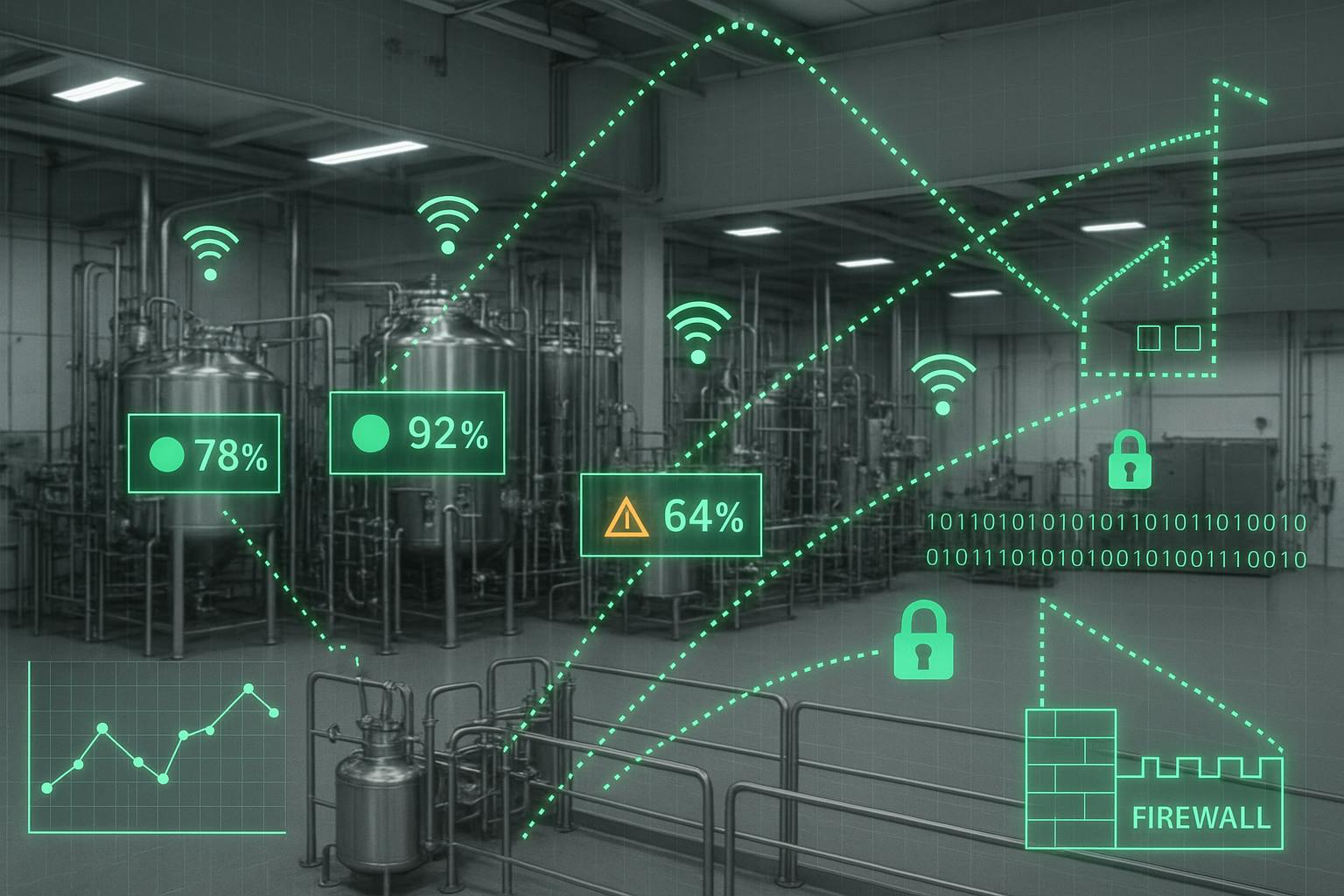The Two Halves of Your Business: A Definitive Guide to Continuous Monitoring for IT and OT Security
May 27, 2025
Continuous Monitoring
In the modern enterprise, we’ve built digital fortresses. We have firewalls, intrusion detection systems, and dedicated security teams vigilantly guarding the corporate network—the world of servers, laptops, and data centers. We operate under a modern security paradigm: a perimeter is no longer enough; we must have real-time visibility inside our network to detect threats as they happen. This strategy is known as continuous monitoring.
But this vigilance often stops abruptly at the factory door.
Beyond the server room lies the other half of the business: the loud, complex, and kinetic world of Operational Technology (OT). This is the realm of industrial control systems (ICS), programmable logic controllers (PLCs), and the machinery that physically creates, moves, and assembles products. For decades, this world was isolated, an "air-gapped" island, safe from the digital threats of the outside world.
That island no longer exists. The convergence of IT and OT has connected the factory floor to the enterprise network, creating unprecedented efficiency and data-driven insights. It has also created a massive, unmonitored attack surface that most traditional security tools are completely blind to.
This is the definitive guide to continuous monitoring for the entire enterprise. We will cover the foundational principles that govern IT security, satisfying the critical need for robust cyber defense. But more importantly, we will bridge the gap into the world of OT, revealing why continuous monitoring for your industrial environment is no longer an option, but an essential pillar of operational resilience, safety, and business survival in the 21st century.
Part 1: The Foundation - Continuous Monitoring in the IT World
To understand its application in the industrial space, we must first master the principles of continuous monitoring in its traditional IT context. It represents a fundamental shift in security philosophy.
What is Continuous Monitoring?
Continuous monitoring is the process and technology used to automate the observation and detection of cybersecurity threats, vulnerabilities, and compliance deviations in real-time or near-real-time. It is a move away from periodic, snapshot-based security assessments (like an annual penetration test or quarterly audit) towards a state of constant, automated vigilance.
Instead of asking, "Were we secure last Tuesday?" continuous monitoring answers the question, "Are we secure right now?"
The NIST Framework: A Blueprint for Continuous Monitoring
The U.S. National Institute of Standards and Technology (NIST) provides a widely adopted Risk Management Framework (RMF) that offers a structured approach to continuous monitoring. It's a cyclical process that ensures the program remains effective and adapts to new threats:
- Define: Establish the scope, risk tolerance, and objectives of your monitoring strategy.
- Establish: Design and implement the technical and procedural architecture for your program.
- Implement: Deploy the monitoring tools and begin collecting data.
- Analyze & Respond: Analyze the collected data to identify attacks and trigger incident response playbooks. This is the active, real-time component.
- Review & Update: Regularly review the effectiveness of the program and update the strategy and tools as the threat landscape and your organization evolve.
Part 2: The Disappearing Air Gap - The Critical Need for OT Monitoring
For years, the universal answer to OT security was the "air gap"—a physical separation between the industrial network and the IT network. In today's connected world, the air gap is a myth.
The Great Convergence and The Great Risk
To power smart manufacturing initiatives, predictive maintenance, and supply chain analytics, businesses are connecting their OT environments to IT systems. This IT/OT convergence allows data from a production line to flow directly to an enterprise resource planning (ERP) system, enabling unprecedented efficiency.
However, it also creates a digital bridge for threats to cross over. A ransomware attack that starts with a phishing email on an IT network can now pivot and travel into the OT network, shutting down physical machinery and halting production. The consequences of an OT breach are fundamentally different and often more severe than an IT breach:
- IT Breach: Data theft, financial loss, reputational damage.
- OT Breach: Production downtime costing millions per hour, spoiled products, catastrophic equipment damage, environmental release, and—in the worst-case scenario—injury or loss of life.
The Industry 4.0 Accelerator: IoT, Third Parties, and the Expanding Attack Surface
The risks of IT/OT convergence are being amplified by the relentless pace of Industry 4.0 adoption. This wave of innovation introduces two significant risk factors:
- The IoT Explosion: Factories are being flooded with new, connected devices—smart sensors, wireless torque tools, advanced robotics, and environmental monitors. Each of these IoT devices is an endpoint. It has an IP address, it communicates on the network, and it is a potential entry point for an attacker. Without monitoring, the network becomes a chaotic digital "wild west," where unknown and unmanaged devices can connect freely.
- Third-Party and Vendor Risk: Modern machines are complex. Maintaining them often requires specialist technicians from the original equipment manufacturer (OEM) to access them remotely. Providing a vendor with a VPN connection directly into your OT network is a massive but necessary risk. A threat actor could compromise the vendor's network and use that legitimate connection as a superhighway into your most critical systems.
A robust continuous monitoring strategy is the only way to manage this new reality. It allows you to automatically discover every new IoT device, learn its normal behavior, and immediately spot if it starts acting maliciously. It enables a "trust, but verify" approach for vendor access, ensuring a remote technician's connection only communicates with the specific machine they are servicing, during the approved maintenance window, and does nothing else.
Why Traditional IT Security Tools Fail in OT
You cannot simply point your IT vulnerability scanner at the factory floor and expect it to work. Traditional IT tools are not just ineffective in an OT environment; they are actively dangerous.
- Different Languages (Protocols): Your IT network speaks standard languages like TCP/IP. Your OT network speaks a multitude of specialized industrial protocols like Modbus, Profinet, DNP3, and EtherNet/IP. IT security tools do not understand this grammar.
- Different Priorities (The Mission): IT security prioritizes Confidentiality, Integrity, Availability (CIA). OT security prioritizes Safety, Availability, and Control. You cannot take a sensitive production line controller offline for a vulnerability scan.
- Different Environments (The Assets): The OT world is full of "legacy" assets—controllers and PLCs that are 20 years old but work perfectly. You cannot install a security agent on them, and they will often crash if probed aggressively by an IT scanner.
Part 3: Building an OT Continuous Monitoring Strategy
Securing the industrial environment requires a purpose-built approach that respects the unique constraints and priorities of OT. It’s a strategy built on passive observation and behavioral analysis.
- Step 1: Gaining Visibility (Asset Inventory): The first rule of security is: you can't protect what you can't see. Use a passive monitoring tool to listen to network traffic and automatically discover and map every single device without disrupting operations.
- Step 2: Understanding "Normal" (Network Baselining): Once you know what's on your network, the next step is to understand how it behaves. An effective monitoring platform spends time learning the normal, legitimate communication patterns of your operation. It learns which devices talk to which, with what protocols, and at what times. This becomes your baseline for "normal."
- Step 3: Detecting Anomalies (Threat Detection): With a stable baseline established, the system's primary job is to detect any deviation. This is how threats are caught—whether it's a PLC trying to connect to the internet, a compromised vendor laptop trying to access an unauthorized machine, or a new IoT device behaving erratically.
- Step 4: Contextualizing and Responding: An alert without context is just noise. A robust OT monitoring solution provides crucial context to help teams respond effectively. The alert shouldn't just say, "Anomalous command detected." It should say, "PLC-FINISHING-LINE-A received a command from an unauthorized source that could alter the motor speed, potentially causing equipment damage."
Secure Platforms in a Monitored World: The 'Job-Zero' Philosophy
While Factory AI does not offer a continuous monitoring solution, we are one of its biggest champions. Our platform’s ability to deliver game-changing AI and predictive maintenance insights depends on its ability to connect to your operational assets securely and reliably. A robust continuous monitoring strategy implemented by our customers is a critical enabler of this secure digital transformation.
At Factory AI, we operate with a "security is job-zero" philosophy. We believe that security is not a feature; it is the fundamental prerequisite for everything we do. Our role is not to monitor your network, but to ensure that the platform you connect to your network is fortified at every level.
By building our platform on world-class cloud infrastructure like Amazon Web Services (AWS), we leverage a security architecture trusted by the most demanding organizations on the planet, including military and government agencies. This allows us to provide an exceptionally secure environment for your operational data. Every piece of data, whether it's moving from your factory to the cloud or being stored for analysis, is protected by military-grade encryption.
This creates a powerful defense-in-depth approach. You, our customer, implement continuous monitoring to secure your network environment and verify all traffic. We, as your partner, ensure our platform and its connections adhere to the highest possible security standards. This shared responsibility is the bedrock of a secure and successful Industry 4.0 deployment.
Conclusion: Your Fortress Has Two Halves
For too long, we have focused our security efforts on one half of the business while leaving the other—the engine of value creation—exposed. Continuous monitoring is no longer just an IT best practice; it is an essential business strategy for any modern industrial enterprise.
The risks are too high, and the threats are too real to operate with a blind spot. Gaining real-time visibility into your factory floor is the first and most critical step toward building a truly resilient operation. It creates the secure foundation required to confidently deploy innovative platforms like Factory AI, protecting your people, your profits, and your processes as you step into the future of manufacturing.

Tim Cheung
Tim Cheung is the CTO and Co-Founder of Factory AI, a startup dedicated to helping manufacturers leverage the power of predictive maintenance. With a passion for customer success and a deep understanding of the industrial sector, Tim is focused on delivering transparent and high-integrity solutions that drive real business outcomes. He is a strong advocate for continuous improvement and believes in the power of data-driven decision-making to optimize operations and prevent costly downtime.